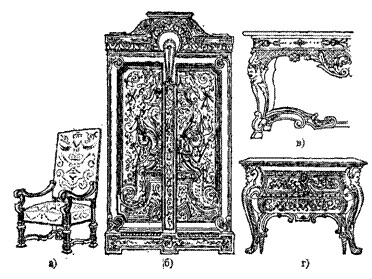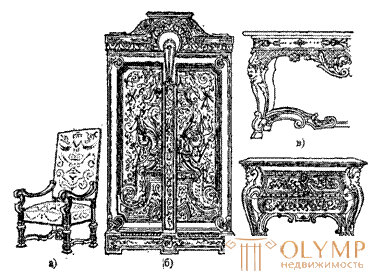
By the middle of the XVII century. in France, the absolute power of the monarch is strengthened. Palace construction is gaining tremendous proportions, the peak of which is the creation of a suburban royal residence in Versailles. Versailles will become not only a subject of admiration, but also an object for numerous imitations during the construction of the residences of other European kings, princes and dukes. The ensemble of Versailles consisted of a monumental palace, gardens, pools and fountains. The composition of the ensemble is subject to strict court etiquette. The creation of the Versailles ensemble was headed by the architects L. Left and J. A. Mansart.
The layout of the Versailles Palace is dominated by the enfilade principle (connecting the rooms to each other through doorways that are located on the same straight line), which is most strongly manifested in the solution of the Mansard mirror gallery. The gallery essentially becomes, as it were, a prospectus reaching 73 m in length and covered with an enormous vaulting. Huge composite mirrors give the hall a special luxury. The royal bedroom is included in the enfilade system, where the king’s bed is separated by a low balustrade from the current flowing courtiers. The decoration of the ceremonial halls of Versailles is extremely luxurious.
The walls, divided into separate panels, are lined with multicolor marble and decorated with columns and pilasters, between which are placed stucco gilded compositions. Friezes, cornices and ceiling painted with the best masters of France.
In the chambers that are not decorated with marble, the walls are covered with expensive fabrics that vary depending on the time of year: in winter, with green or dark red velvet with gold galloon; in the summer, a brocade with gold or silver pattern and multicolored silk.
There were few furniture in the halls: stools and several tables with vases. Placed it strictly along the walls.
This period is characterized by the presence of two different techniques of furniture. Cabinet furniture is finished with wood veneer, followed by decorating surfaces of various kinds of inlays and overhead metal parts, and tables, chairs and stools do not plywood, but gold.
During this period, such forms of cabinet furniture as cases with standing clocks and first bureaus were created, so in the 17th century. began to call desks, the cover of which was pasted over with cloth (bure, French. - thick cloth). These offices have two small drawers under the lid. They carry out ebony offices and decorate with gilded embossing with bronze on the corners, legs and drawers.

Fig. 1. French Baroque furniture (Louis XIV era): a - an armchair, a b-wardrobe by Buhl, c - a console, d - a chest of drawers
The main place in the decoration of the palace premises belongs to the offices, which are also mostly made of ebony. Their supports are groups of columns or caryatids. Doors, richly decorated, hide the rows of richly decorated drawers and a special internal portal, resembling a theatrical scene with decorations. The front of the cabinet is decided as the facade of a baroque building with protrusions, cornices, a balustrade and pediment.
Armchairs (Fig. 1, a) are upholstered with decorative fabric. The legs in the form of four-sided balusters are, as it were, recruited from several square and pyramidal elements, each of which is decorated. The horizontal connections under the seat are strongly curved, the curvilinear sections alternate with the straight.
Armchairs, sofas, chairs in this era are usually very high back, ending above the head sitting. The legs are pyramidal (top down), decorated with profiling, or in the form of curved S-like curls, the ends of which are decorated with acanthus leaves. In chairs for old men, two semicircular protrusions appear from the sides of the back, a chaise lounge — a chair with a strongly bent back and an elongated seat for elongated legs — comes into use.
The sofas are connected, as it were, from three chairs placed side by side, thanks to which one common plane of the seat and back is formed, which are upholstered with rich decorative fabric of bright tones, made on the royal manufactories of Gobelins, Bove and Aubussons.
Tables are given a round or rectangular shape. The legs are vertical, richly inlaid and decorated at the top with bronze female heads with an elongated oval face and a magnificent hairstyle turning into curls of the ornament. Later, the legs at the narrow ends of the table are treated in the form of a lira, as in Italian tables. The valance and the edges of the dining room are decorated with rich carvings and inlays.
During this period, many famous furniture craftsmen worked in France, but the most famous was Andre Charles Boule (1642-1732), a Flemish of origin, who became famous for the art of inlay.
Boule created massive cabinets (fig. 1, b), tables, dressers, standing clocks, veneered with ebony and decorated with a peculiar ornament. The finest baroque patterns, curls and leaves cut from copper, tin, sometimes silver, stand out against the background of plates of polished tortoise shell. The furniture solution is complemented by large jewelery made of perfectly bronzed bronze. Sometimes the opposite - a pattern of a turtle and tin hovers on a copper board. Often Boule in the center of the ornament placed luxurious vases with butterflies fluttering around, collected from colored wood.
Boule used the following technique: two thin plates — a tortoise and a copper one — were lightly glued to each other, a pattern was applied to one of them, which was simultaneously sawn through a plate with a loose saw, until the pattern fell out of them. Then put the copper pattern in the tortoise background and vice versa. The result is a triple effect: the thinnest fit of the parts to each other, the ability to simultaneously create two objects and, finally, the complete absence of waste, which is very important when using valuable material. The tortoiseshell board with a copper pattern is called the first batch, the copper one with a tortoise pattern is called the second, or counter party. In the presence of a tin pattern, sawn through three boards.
The development of this technique was the "pique" technique, when the gold thread was stuck into the tortoise plate, then sawed off, and the surface was polished. The picture was obtained in dots.
Decorative console tables (fig. 1, h) on two legs, placed under the mirror, are beginning to be widely used. The carved base of the console is completely covered with gilded figured carvings. The bizarrely curved legs of the undervolt at the bottom are fastened with a prong. The middle of it was usually decorated with a massive carved cartouche with a royal cipher or coat of arms.
The canopy bed had no vertical supports.
Around 1700, new types of furniture appeared: chests of drawers (Fig. 1, d), desks and pedestals for sculptures.
By the middle of the XVII century. leading role in the art of furniture from Italy passes to France. French influence is intensifying in other countries, aided by the high artistic level of French furniture. Freedom of composition, rich decoration are restrained and balanced by clarity and rationality of forms anticipating classical art,
Что бы оставить комментарий войдите
Комментарии (0)